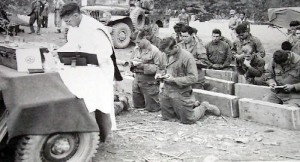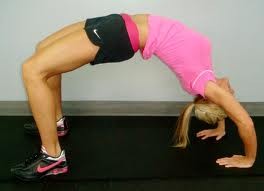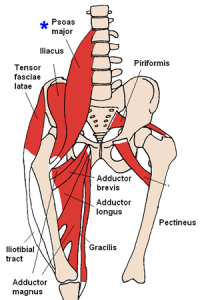Low back pain is something almost everybody experiences at some point in their life. And once we've suffered through some low back pain we usually want to know what caused the pain and what to do about ensuring it doesn't happen again. And while there may be a variety of causes and types of low back pain there are some things in common to all. First of all, in order to prevent future episodes of low back pain we want to to ensure we have a solid foundation and can move through an optimal range of motion. To look at the first condition for a solid foundation we need to consider our posture. Do the joints of the body stack evenly like pieces of lego? Or are there some areas where they are deviations from optimal alignment and smooth curves? This may get tricky for the lay person because how are they to know what is optimal? And often times manuals and references used technical terms which can confuse even people who work in the fitness industry. In this case I like the way Dan John describes the relationship of the hips and pelvis with the torso. He has described this as a box (torso) sitting on a bowl of water (hips & pelvis). Does the box sit squarely on the bowl of water? And is any water leaking out of the bowl of water? If so, is water leaking out of the front of the bowl (anterior tilt) or the back of the bowl (posterior tilt)? If the rib cage is flared or tilted up than the box is not sitting squarely on the bowl of water. And if we are spilling water than we know how to correct this problem as well. The solution comes via the kneeling plank. It...
What to do about tight hamstrings
Ask 100 people that train where they are most tight and you will probably hear hamstrings singled out as one of the most common problem areas. I would include tight hips as well as the two are intimately related and if you have tight hamstrings more than likely have tight hips as well. So first of all, if this really a case of tight hamstrings? And, if so, what can you do about it? To answer the questions to these we need to go back the basics. This means evaluating a person's static posture. I like the way Dan John describes the relationship of the hips/pelvis and the rib cage. He says to imagine the hips/pelvis as a bowl of water with a box sitting on top. Does the bowl of water sit level? Or is there water leaking out of the front (anterior tilt) of the bowl? Or out of the back (posterior tilt)? Before we can even start to think of lengthening or shortening any of our tissues or structures we need to know that the foundation is solid. A quick and easy drill to learn the range of the hips and pelvis is the cat and camel. Starting on hands and knees imagine spilling water out of the front of the bowl. You should notice an increased arch through the low back. Next try and spill some water out of the back of the bowl. Dr. Jeff Cubos, who presented at the inaugural OSCC, used the analogy of trying to scoop ice cream with your butt. Use whichever analogy works for you. http://youtu.be/CXRsjICsGnc Once we have established a neutral hip and pelvic position we need to recognize that tight hamstrings may also be due to weak lower abs and/or hip flexors. Think about it this way. If you had...
Back Bridge - The Anti-Sitting Exercise?
It seems like everyone is familiar with the problems of too much sitting. From tight hips, weak glutes, forward head position, flexed wrists, slumping into poor posture and a lack of caloric expenditure it's easy to find reasons to hate on sitting. So instead we opt for different ergonomically designed chairs. Or sit on stability balls (which still allow for all the same problems described above). We raise our desks so we have to stand to work at them. We drink more water to force us to stand every so often to use the bathroom. And some people have figured out the benefits of kneeling versus sitting. But even if we change our work or study environment to eliminate sitting there are still times when we will have to sit. Unless you own a Pope-mobile or a Segway I'm sure your daily commute involves some sitting. As do certain meetings, meals in restaurants, nights out to the movies or theatre and trips to the bathroom. If we can't eliminate all sitting from our lives maybe we should be incorporating more anti-sitting drills and exercises into our training? I think a lot of good coaches are already doing this by programming extra posterior chain work for the glutes and low back while putting the client in a kneeling or standing position. Is there anything else we could do to undo the effects of sitting? Sure and it's something most of learned how to do at a young age and it's the back bridge. ***short disclaimer...the back bridge requires high levels of mobility at the wrists, shoulders and hips and is not recommended for those with any type of pre-existing back condition...if you pass the clearance tests just described than feel free to try the easiest versions first and build up muscular endurance...
Tight Hips - Real Client Solution
Do you remember one of the things many teachers would say at the beginning of the year? You know when everyone is new to a class and nobody feels comfortable to ask a question? And even when the teacher would put a question to the students everyone would stay quiet. And so at a certain point the teacher would say questions are great because usually there is someone else thinking the same thing. This is the inspiration for this post. Hopefully the content helps a number of you as well with your training. Let's get at it. The other day Joanne K. was doing front squats and mentioned that often feels restricted in the hips. I say hips plural because she mentioned that the restriction alternates between right and left depending on the day. [caption id="attachment_3037" align="alignleft" width="200"] Psoas, one of the hip flexors So here's what we did.First of all I took a look at Joanne's squat pattern. This involves looking all sides and examining for alignment, depth and symmetry. What stood out was there was a slight collapse of the left knee. Now we had something to address. First we had her foam roll the left adductor followed by an exercise to activate the left external hip rotator. For this we used a banded clam shell exercise. This took all of about 5 minutes, or less, to do. When Joanne retested her squat she said it was substantially better without a pinching at the hip. But what about the fact the issue seemed to alternate from right to left depending on the day? Well first we'll assume the warm-up and training is performed in a balance matter. Then the other thing to examine is activities of daily living which may contribute to this imbalance. In this situation we discovered...


